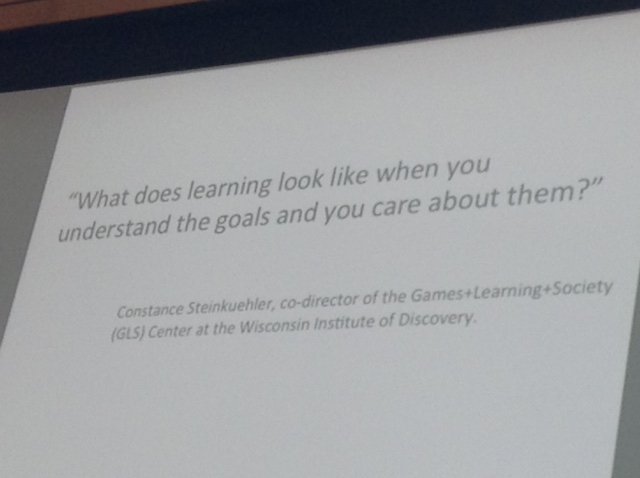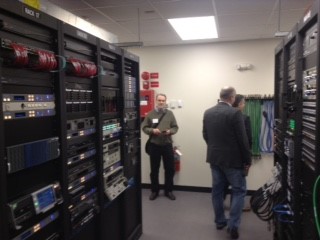Searching for "instructional design"
Academy of distinguished teachers, Innovation
University of Minnesota, McNamara Alumni Center – Twin Cities Campus. April 8, 2015
Full program available here: https://guidebook.com/g/adt/

Randy Bass
Randy Bass
https://www.linkedin.com/pub/randall-bass/14/94/77
flipping disruption into Design
there are two type of universities: the ones that are in control of change and the ones, which are pressed to change.
what kind of education is needed at this moment of history.
Assumptions: 5-10 years will be for a first time outcompeted in terms of delivering information and degrees. What is that the university can do distinctively well that WWW cannot do: mentored learning and the arc of learning (beyond collection of granular separate learning)
book: The New Division of Labor. http://www.amazon.com/The-New-Division-Labor-Computers/dp/0691124027
External forces of potential disruption: 1. MOOCs, nearly free education, 2. skilled-based learning (Codeacademy, Udacity), 3. data analytic 4. public pressure on access, metrics of impact.
Gartner group (http://www.gartner.com/technology/home.jsp) hype cycle : overvalued in a short term and undervalued in a long term. MOOC is excellent example.
NMC: competing models of education.
learning analytics. adaptive learning, intelligent tutoring etc. Open Learning Initative. http://oli.cmu.edu/
In the 19th century, railroads companies which were in the business of railroad companies went under; the ones which were in the business of transportation survived. Parallel, universities, which are in the business of delivering information will die out; the ones, which will survive must look to a very different picture.

formative wider outcomes
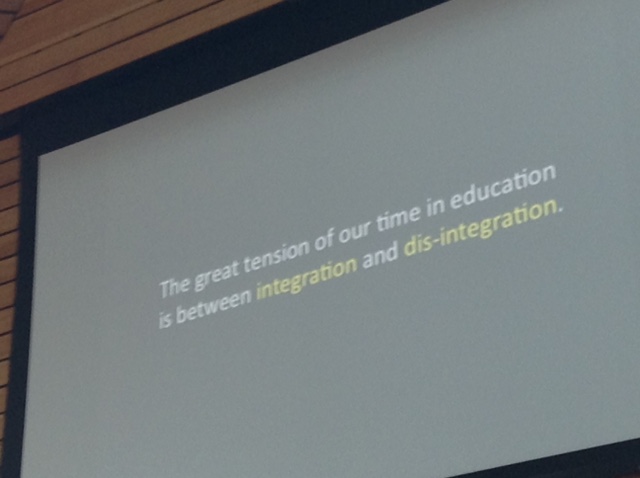
integration and dis-integration
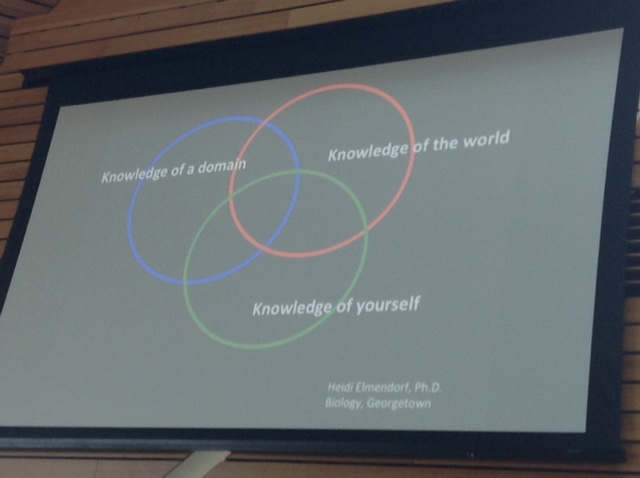
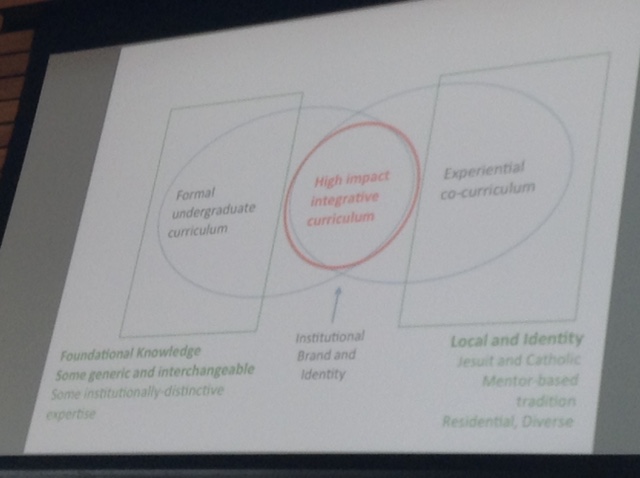
high impact integrative curriculum

what makes high inpact practices high impact
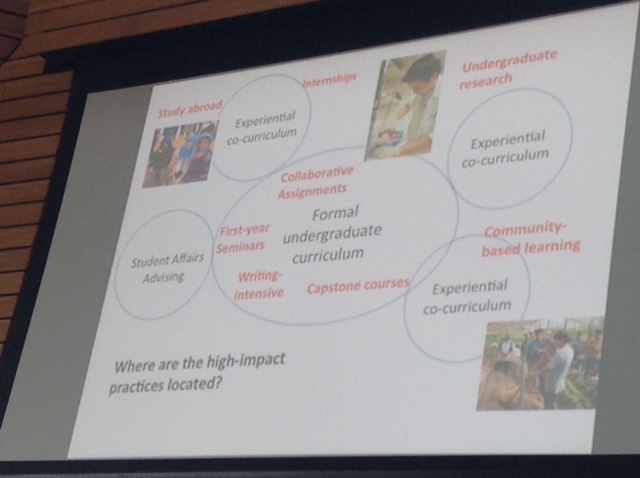
formal versus informal
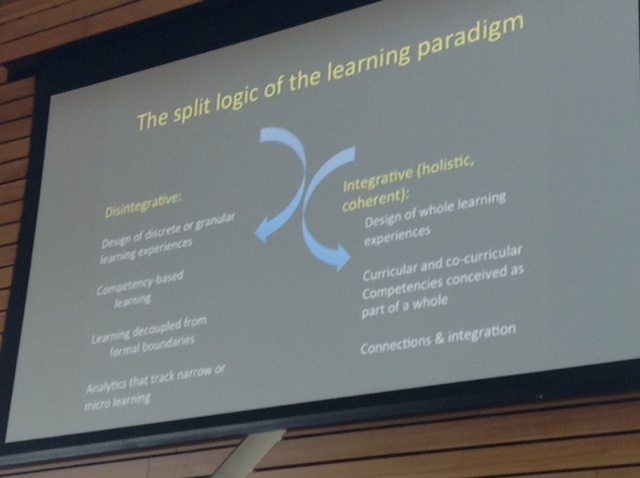
Selected sessions:
The Value of Assessing Outcomes of Teaching Methodologies to guide instructional design
https://guidebook.com/guide/33541/event/10594685/
game-based learning:
Upping your Game – Best Practices in Using Game-Based Learning
https://guidebook.com/guide/33541/event/10594684/
Implementing Game Dynamics in Moodle
https://guidebook.com/guide/33541/event/10693434/
visuals:
Engaging Students through Video Integration
https://guidebook.com/guide/33541/event/10676389/
https://guidebook.com/guide/33541/event/10676375/
Using Flipgrid Video Commentary to Share Student Learning
https://guidebook.com/guide/33541/event/10676361/
————
Enhancing learning with online narrated presentations using VoiceThread
https://guidebook.com/guide/33541/event/10676372/
flipped:
Essential Technology & Tools for Flipping Your Classroom
https://guidebook.com/guide/33541/event/10676385/
Improving Delivery of Technical Course Content through Incremental Use of Classroom “Flipping”
https://guidebook.com/guide/33541/event/10676376/
https://guidebook.com/guide/33541/event/10594850/
The Pros and Cons of Flipping the Classroom
https://guidebook.com/guide/33541/event/10676323/
Using Google Forms for Student Group Evaluations
https://guidebook.com/guide/33541/event/10734863/
Library:
The University Libraries Partnership for Affordable Content – Enhance Student Learning and Save Them Money!
https://guidebook.com/guide/33541/event/10676358/
CRS Tophat:
Using Classroom Debates as an Interactive Learning Tool in a Course on Companion Animal Ethical Issues
https://guidebook.com/guide/33541/event/10676369/
online:
Adapting the Harvard Case Method for Online Courses
https://guidebook.com/guide/33541/event/10595018/
Readiness Assessment for Online Courses
https://guidebook.com/guide/33541/event/10595040/

technology showcase general view
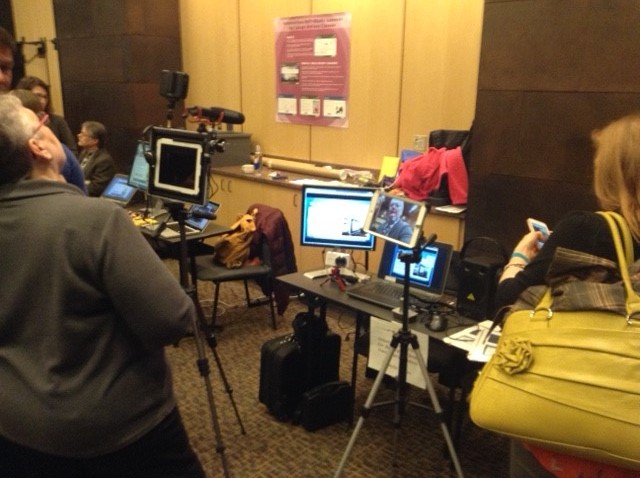
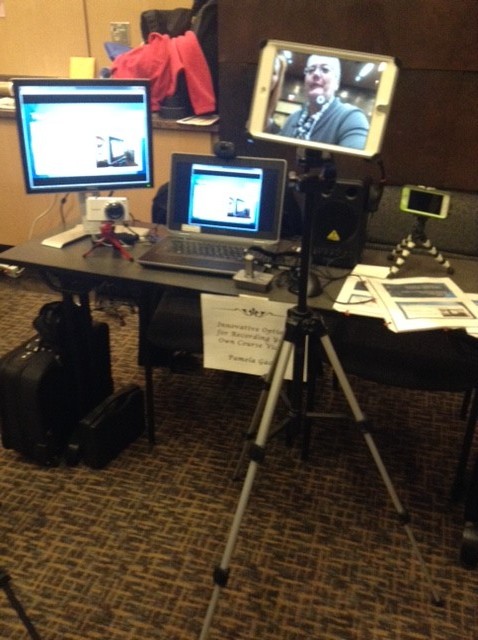
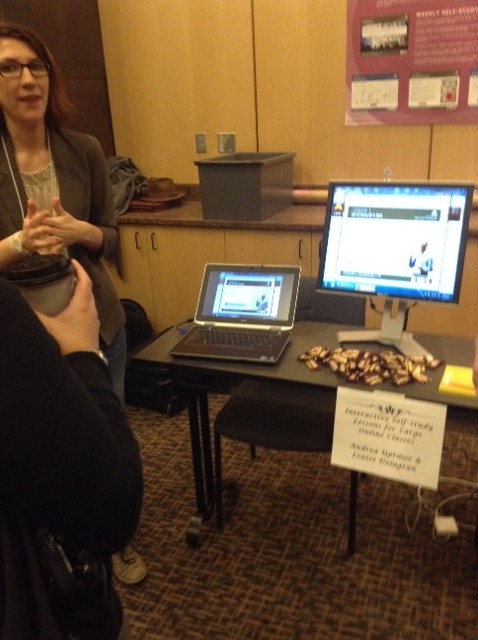


Midwest AV Summit

Matthew Clay : Active Learning Spaces
partners across campus for IT/AV: CETL
What is the most important key for creating active learning spaces (ALS).
Mathew shared his work with CETL and his understanding of the importance of faculty being brought to the table. Faculty as equal stakeholder in the process.
In a conversation with him after the presentation, he agreed that faculty must be the leading force in in generating ideas what new technology and how to implement technology in the classroom. He agreed that at the present IT/AV staff is the leading force and this is a corrupt statuquo
key partnerships:
faculty and academic affairs, students, facilities, architects, engineers, contractors, furniture vendors, IT (networking, support instructional design)
challanges: ITS mindset (conservative), Administration must be on board (money), Funding.
MnSCU is not Google friendly. 60% of the staff is not doing the same tasks as 3 years ago.
Open about challenges, sharing more with faculty. Nice to hear this, but the communication must be much larger, to the point when faculty are equal partners in a relationship, which is not far from equal decision making.
If faculty is not considered a REAL stakeholder (versus intimated body in a meeting which is controlled by IT people), the entire technology use goes down the drain. Faculty is much stronger relationship with students then IT is with students. The presentation put weight on IT staff and its connection with students’ needs. It is questionable how IT staff can make stronger connection then faculty, who are in a daily contact with students.
The issue is how to assist faculty to catch up with the technology, not how IT staff to rival faculty in their connection with students. What faculty lacks in understanding of technology cannot be replaced by IT staff increasing interaction with students, but rather assisting faculty with coming to terms with technology.
maintaining innovation: fail fast and fail forward; keep up to date with technology (blank statement); always look for new furniture; focus on space design instead of just A/V; Challenge yourself with new ideas; always learn from your mistakes; always get feedback from students and faculty (again, the PERIPHERAL role of faculty. Is feedback all expected from faculty? It faculty and IT staff must be equal partners at the decision table. not faculty being consulted at decision made by IT staff)
Google Glass mentioned, Pebble watches. supposedly to understand students habits. Big data used to profiling students is very fashionable, but is it the egg in the basket?
they have 3d printer, Inoculus. Makerspace mentioned
examples how to use 3d printing for education (LRS archive collections, MN digital library).
the presenter kept asking if there are questions. it makes me wonder how far back (pedagogically or androgogically) IT staff must be to NOT consider backchanneling. Social media is not a novelty and harvesting opinions and questions using social media should not be neglected

digital classroom breakdown session
Break down session: Digital Classroom
technical, very IT. I am not versed enough to draw impression on how it projects over real faculty work. HDMI cables.
relating to the previous presentation: I really appreciate the IT / AV staff handling all this information, which is complex and important; but during my 15 years tenure at SCSU I learned to be suspicious of when the complexity and the importance of the techy matter starts asserting itself as leading when the pedagogy in the classroom is determined.
HD flow and other hardware and software solutions
VLAN 3. lecture capture.
BYOD support in the classroom: about half of the room raised their hands.
The 2015 Teaching Professor Conference is the place to hear about the latest pedagogical strategies.
The cut-off date for submitting a proposal to the
2015 Teaching Professor Conference is approaching fast!
All proposals must be submitted by October 31, 2014.
The Teaching Professor Conference is known for attracting a roster of high-quality, engaging presenters; that’s why we’re asking you to be a part of next year’s event. If you have previously submitted a proposal for past conferences, we sincerely ask you to submit again. And if you have never submitted a proposal for a session or poster session, we ask that you seriously consider this opportunity to share your expertise at the conference.
The 12th annual Teaching Professor Conference will be held May 29-31, 2015 at the Sheraton Atlanta Hotel, Atlanta, GA.
Featured topical areas are:
Topical Area 1: Instructional Design
Topical Area 2: Activities that Engage Students
Topical Area 3: Teaching Specific Types of Students
Topical Area 4: Instructional Vitality: Ways to Keep Teaching Fresh and Invigorated
Topical Area 5: Teaching and Learning with Technology
Topical Area 6: Creating Climates for Learning
Topical Area 7: Faculty Development
For more information about the proposal process and how to submit your proposal, please click here: http://www.teachingprofessor.com/conference/proposals.
The Teaching Professor Conference is three intensive days of plenary sessions, preconference workshops, sessions, poster sessions, and more. Here is your chance to be a part of it in 2015.
Deadline for proposal submissions is Friday, October 31st, 2014.
http://www.alastore.ala.org/detail.aspx
eCourse outline
Part 1: Introduction and Engagement—Getting Users through the Door
- A brief overview of how library instruction has developed for more than 100 years
- A brief review of how library instructions is evolving to meet users’ changing needs
- Identifying what must be learned and how we can encourage effective learning (needs assessment)
Part 2: Preparing for Delivery—Thinking from a User-Centric Point of View
- A brief overview of instructional design techniques
- Thinking about the audience and how to create learning opportunities that stick
- The importance of preparation
Part 3: Delivering Learning for Positive Results—Providing Learning that Lasts
- Creating learning environments that facilitate success
- Keeping learners awake and engaged
- Encouraging learning through facilitation of discussion and exploration
- Setting learners up for success
Part 4: The End is The Beginning: Libraries as Onsite-Online Social Learning Centers
- What to do when formal learning ends and learners leave the learning face-to-face or online learning space
- Providing a place where learners can succeed
- Evaluating for success
- Returning to the beginning with new and improved learning opportunities
Amidst discussions at LRS and forthcoming strategic planning –
The LinkedIn Higher Education Teaching and Learning group has a discussion started:
“The library as space is becoming more important, even as students are able to log on to databases from wherever.”
based on the the article
Spikes, Stacks, and Spaces
from Inside Higher Ed blog: https://www.insidehighered.com/blogs/confessions-community-college-dean/spikes-stacks-and-spaces
-

Julie
-

Andrea
-

Russ
-

Sharon
-

Laura
-

Dr..Myrna
Gamification: It’s Easier than You Think!
https://desire2learn.adobeconnect.com/_a707373752/p3mhvdh5gfb/
BONUS: several cool infographics on gamification of education: http://elearninginfographics.com/tag/gamification-infographic/
this is a recording of a webinar, which took place yesterday, September 3, 2014. The presenter is Canadian. Sean Isles
https://www.google.com/?gws_rd=ssl#q=ontario+sociology+gamification+sean
Gamification versus game based education
Gamification is application of typical elements of game play to unconventional areas
Game based is learning that takes place withing a game simulated environment itself
D2L offers options for gamified education
Leveling / Gating: turn off/on content modules by weekly increments.
Bosses/Challenges – simple quiz at the end of each module (training quizzes, open to take unlimited times)
Celebration of successes – emails from intelligent agents, short funny video, etc.
Intelligent agent send an email not only to student, but to an office, where top scoring students can get a gift.
Game-based
simulator. used Unity to create the game
Shaun Iles: shaun.iles@mohawkcollege.ca and Brian Gould: brian.gould@mohawkcollege.ca
Leaderboard – Brightspace.com – Brightspace by D2L. needs to be purchased, but allows modify and customize with HTML and CSS
Badges: meaningless if the entire institution is not on board. google and mozilla badges platforms. D2L is about to roll out badges, only if the entire institution and the business recognize them. otherwise, the badges are dead upon exit from class.
make discussion interactive through upvote: http://www.reddit.com/r/upvote/
Scavenger hunt mentioned. Bluetooth info beacons used across campus to enable scavenger hunt. Across mobile devices.
Librarians and instructional designers mentioned.
His D2L home page has twitter widget and skype widget. He says the Skype widget enormously used. When will my proposal for Adobe Connect Widget will be addressed, am asking I for years?
http://cdn.nmc.org/media/2014-nmc-horizon-report-library-EN.pdf
p. 4 new and rapidly changing technologies, an abundance of digital information in myriad formats, an increased understanding of how students learn evolving research methods, and changing practices in how scholars communicate and disseminate their research and creative work.
Engagement requires an outward focus
A liaison who understands how scholars in a particular discipline communicate and share
information with one another can inform the design and development of new publishing services, such as
digital institutional repositories.
Liaisons cannot be experts themselves in each new capability, but knowing when to call in a
colleague, or how to describe appropriate expert capabilities to faculty, will be key to the new liaison role.
an increasing focus on what users do (research, teaching, and learning) rather than on what librarians do (collections, reference, library instruction).
hybrid model, where liaisons pair their expertise with that of functional specialists, both within and outside of libraries
p. 6 Trend 1: Develop user-centered library services
Many libraries are challenged to brand such a service point, citing a “hub” or “center” to refer to services that can include circulation, reference, computer support, writing assistance, and more.
For liaisons, time at a reference desk has been replaced by anticipating recurrent needs and developing
easily accessible online materials (e.g., LibGuides, screencasts) available to anyone at any time, and
by providing more advanced one-on-one consultations with students, instructors, and researchers who
need expert help. Liaisons not only answer questions using library resources, but they also advise and
collaborate on issues of copyright, scholarly communication, data management, knowledge management,
and information literacy. The base level of knowledge that a liaison must possess is much broader than
familiarity with a reference collection or facility with online searching; instead, they must constantly keep up
with evolving pedagogies and research methods, rapidly developing tools, technologies, and ever-changing
policies that facilitate and inform teaching, learning, and research in their assigned disciplines.
Librarians at many institutions are now focusing on collaborating with faculty to develop thoughtful assignments
and provide online instructional materials that are built into key courses within a curriculum and provide
scaffolding to help students develop library research skills over the course of their academic careers
p. 7 Trend 2: A hybrid model of liaison and functional specialist is emerging.
Current specialist areas of expertise include copyright, geographic information systems (GIS), media production and integration, distributed education or e-learning, data management, emerging technologies,
user experience, instructional design, and bioinformatics.
At the University of Guelph, the liaison model was abandoned altogether in favor of a functional specialist
approach
p. 8 Trend 3: Organizational flexibility must meet changing user needs.
p. 9 provide education and consultation services for personal information management. Tools, workshops, websites, and individual consults are offered in areas such as citation management, productivity tools, managing alerts and feeds, personal archiving, and using social networking for teaching and professional development.
p. 11 data management, knowledge management and scholarly communication
digital scholarship
p. 12 Liaisons need to be able to provide a general level of knowledge about copyright, data management, the need for metadata and the ontologies available in their disciplines.
p. 13 Liaisons need to be able to provide a general level of knowledge about copyright, data management, the need for metadata and the ontologies available in their disciplines.
p. 16 replacing the traditional tripartite model of collections, reference, and instruction
147 Practical Tips for Teaching Online Groups
http://home.fau.edu/musgrove/web/communication/PRACTICAL%20TIPS%20FOR%20TEACHING%20ONLINE%20GROUPS.pdf
44. Teaching in an online environment should be a team effort. You should be
able to call upon technology specialists, instructional designers, and many
others to help you develop and implement your course.
Q:
Hi all,
Please excuse duplication but I’m trying to get this to as many people as possible.
There are two courses in the M1/M2 years in our medical college that are extraordinarily large. In many schools it’s called the “Doctoring” course. Our university uses Blackboard as our LMS, but as there is no real search mechanism in Blackboard, the content is hard to organize and locate. I’ve been trying to think of good options for this type of course and have come up with iTunesU and Moodle with search installed and turned on.
Do any of you have other options you might recommend?
Thanks,
Max~~~~~~~~~~~~~~~~~~~~~~
Max Anderson, MLIS
Instructional Designer, Undergraduate Medical Education
UIC College of Medicine
150 College of Medicine West
1819 W. Polk St. (M/C 785)
Chicago, IL 60612-7332
Phone: 312-996-5898
Fax: 312-413-3410
UGME Website: http://chicago.medicine.uic.edu/ugme
A:
On Wed, Mar 26, 2014 at 10:57 PM, matinga ragatz <matingaragatz@gmail.com> wrote:
@Max
Google Course Builder is free but you do need a bit of html/coding knowledge to get things looking right.
Post an update when you find your solution!
Cheers!!
==============================
Docebo? It is really daunting for online teaching, got me frustrated, but very good for your needs. Or you could Just put them on GDrive in folders and link them to any website (or LMS) that has an embedded discussion forum (G Groups, any LMS Discussion forum).
———–
Ammar Merhbi
Edtech and TESOL, M.A.
Educational Technology Specialist and Head of English Department
Google Apps and Moodle Administrator (http://www.learn.djis.edu.sa )
PD Specialist
What do you know about those?
How can you use them?
What for?
Ideas how they can improve teaching
Ideas how they can improve learning
Ideas how they can improve instructional design
Ideas how they can serve information technology
Ideas how they can serve elearning and mobile learning
Ideas how they can serve gamification.



